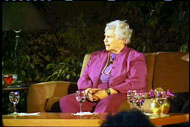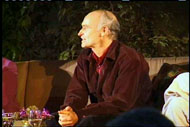Panel of David Tudor's Friends and Collaborators
Audio and Video:
Panel of David Tudor's Friends and Collaborators
 |
|
A collaborative production by the Getty Research Institute and the California Institute of the Arts School of Music. Realized at the CalArts Café, May 17, 2001
This panel entailed an informal conversation among visual artists and musicians who worked closely with David Tudor. They discussed Tudor's interest in collaboration, his role as a teacher, performer, composer, and friend, and his position within the wartime avant-garde. The panel was moderated by Jean Rigg, executive director of the Merce Cunningham Dance Company. A longtime friend of Tudor, Rigg was instrumental in bringing his archive to the Getty Research Institute. In this excerpt, Rigg asks Pauline Oliveros to talk about Tudor's response when she offered her piece, In memorium Nikola Tesla, cosmic engineer (1969), for performance by Tudor and Gordon Mumma, then musicians with the Cunningham Company.
 |
|
The panelists included: Billy Kluver, an electrical engineer who, with Robert Rauschenberg, founded the collaborative organization Experiments in Art and Technology, which produced 9 Evenings: Theater and Engineering at the Armory Center in New York City and on the Pepsi-Cola Pavilion for Expo '70 in Osaka, Japan; Jacqueline Matisse Monnier, granddaughter of Henri Matisse, assistant to her stepfather Marcel Duchamp on the assemblage of his boite-en-valise, and close collaborator with David Tudor on mixed-media installations involving kites and kitetails; Gordon Mumma, co-founder with Robert Ashley of the Cooperative Studio for Electronic Music in Ann Arbor, Michigan, and a performer with the Merce Cunningham Dance Company; Oliveros, a composer and performer who was associated with the San Francisco Tape Music Center and directed the Center for Music Experiment at the University of California, San Diego; and Christian Wolff, a composer who studied with John Cage and joined fellow members of the "New York School" (Cage, Earle Brown, and Morton Feldman) in exploring graphic notation and indeterminacy in the early 1950s.
